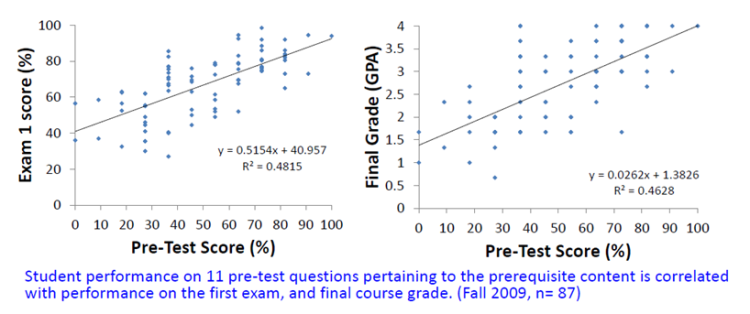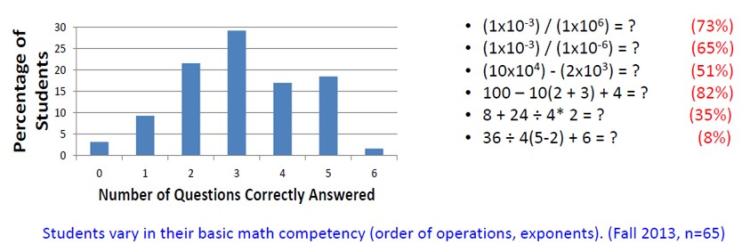
Courtesy of J E Theriot, flickr.com, Courtesy of J E Theriot, flickr.com
Dr. Janet Casagrand created screencasts for her incoming students to watch so that all students would be up to par.
I teach a large, upper division Integrative Physiology courses (IPHY 4720: Neurophysiology). Neurophysiology involves applying electrical and physiological concepts to understand the function of the nervous system. Students need to grasp basic electrical principles and solve various mathematical problems. This semester I wanted to address some challenges I face with variability in students’ incoming competency and preparedness.
The first challenge is that there are considerable differences in how much and how well students remember the basic physiological principles from the prerequisite Human Physiology course, as some take Neurophysiology 1-2 years after the prerequisite course. A good grasp of these concepts is necessary to students’ success in Neurophysiology (see figure below). In the past, I have spent the first week reviewing key concepts (with additional lecture throughout the semester). That is too long for some students, and not nearly long enough for others.

Janet Casagrand measured what students remembered from prerequisite course
A second challenge is that students vary widely in their incoming competency and comfort with the basic mathematics we use (see figure below). In the past, I have worked through sample problems in lecture. However, this is too much for some students, and not enough for others depending on their background.

Casagrand measured her incoming students' mathematics competencies
In the Fall 2013 semester I wanted to explore whether screencasts might be a way to address these challenges. I incorporated two types screencasts into the course: (1) reviews of key concepts from the prerequisite course, and (2) demonstrations of mathematical problem solutions. My hope was that the screencasts would provide support for students who need it, while removing the need to spend as much lecture time on these topics. Students could review topics as needed, and at their own pace. This could provide weaker students with more support, while not boring stronger students. Furthermore, the lecture time that was freed up could be used for other in-class activities, such as case studies.
What are Screencasts?
Screencasts are short (<10 minute), narrated videos which can provide a rich, supplementary resource for students by providing introductions to a topic, solutions to example problems, explanations of concepts, etc. Because screencasts are short, they maintain student interest, yet are complete enough to address a course learning goal. Screencasts are available to students on their own time, and can be paused, replayed, etc. Evidence suggests screencasts are effective in improving student learning (e.g., Lloyd & Robertson 2011; Pinder- Grover et al. 2011; Means et al. 2010; Bergmann & Sams 2008), and that students have a very positive reaction to them and view them frequently (e.g., Pinder-Grover et al. 2011; Falconer et al. 2012). In addition, screencasts can free up lecture time for alternative activities, such as active learning approaches known to improve student learning.
How did I Create the Screencasts?
To create the screencasts I used Camtasia Studio with a headset microphone, and a Powerpoint presentation. This worked very well. I was quickly able to learn how to use the software to create and edit screencasts. I also used a Surface Pro tablet, so I could annotate the Powerpoint slides or show sample problem solutions. I also scripted what I planned to say in advance of filming the screencast.
Twelve screencasts were developed in Fall 2013 and uploaded to Desire to Learn (D2L). Students were then able to view the screencasts using D2L. This allowed me to collect data on which students were viewing the screencasts, how many times they viewed each screencast, and how long they spent viewing each one. I also conducted a survey during the 4th week of classes (before the first exam) to determine student reaction to the screencasts.
The survey (82% response rate) indicated that students predominantly viewed the screencasts as greatly or fairly helpful. Eighty percent of students watched 1 or more screencasts, and those who did on average viewed 6.7 of 12 screencasts (56%). Fifty-six percent of students reported that they watched screencasts to review concepts they did not remember well, and 48% watched them to utilize all resources. The primary reason students gave for not watching screencasts was that they felt they did not need to review topic.
Student feedback on the screencasts suggested that the screencasts were serving their intended goal:
- Screencasts are very useful in helping me to remember concepts from IPHY 3470 (Human Physiology) since it has been 2 years since I took that course.
- I love these, just a great resource and refresher.
- Screencasts are also extremely helpful in reviewing and going more in depth
- I think it’s a good resource for background material, and a potential study aid.
- I used to visit Youtube for addition explanations of concepts that are now covered in screencasts.
- They give a very helpful review of the material that is about to be covered.
I feel that incorporating screencasts into the Neurophysiology course was a beneficial addition that helped address some of the challenges I was facing with the course in terms of variability in students’ incoming competency and preparedness. While the screencasts took a lot of time to create, I feel it was a worthwhile investment of my time as the students responded very positively to the screencasts, and even asked for more. (And I’m planning to develop more for next fall.) I found that having a very detailed script before I began recording the screencast was very important. It made the process of creating the screencast much easier, and the screencasts required much less editing afterwards. In fact, the most time-consuming part of the process was developing the script and deciding exactly what and how much to say. My goal was to keep the videos to 5-10 minutes, which was a challenge for a few topics. If a screencast was running over 10 minutes, I realized I was trying to fit too much content into one screencast, and usually it deserved to be broken into two screencasts. Thus, I really had to reflect and focus on the key points that I wanted students to get in each screencast.
The screencasts were utilized by students at all performance levels (based on final course grades). What I would like to do next is determine whether watching the screencasts helps the weaker students perform better in the course and make up some deficits they may have coming into the course. I plan to use pre-test scores as a measure of projected performance in the course to identify at-risk students, and see if those who watch the screencast perform better than predicted.
As an experiment, I also used the same equipment to record my lectures, which were posted on D2L. The recorded lectures were widely used by students (with 68% of students reporting watching 1 or more). I was initially concerned that posting the recorded lectures might impact class attendance, but this did not happen. Rather, the primary reason that students reported watching the recorded lectures was for review. One student commented that “Knowing I can watch the recorded lecture makes the panic of taking notes much less stressful, allowing for more focused learning in the classroom, and reviewing it at home”.

